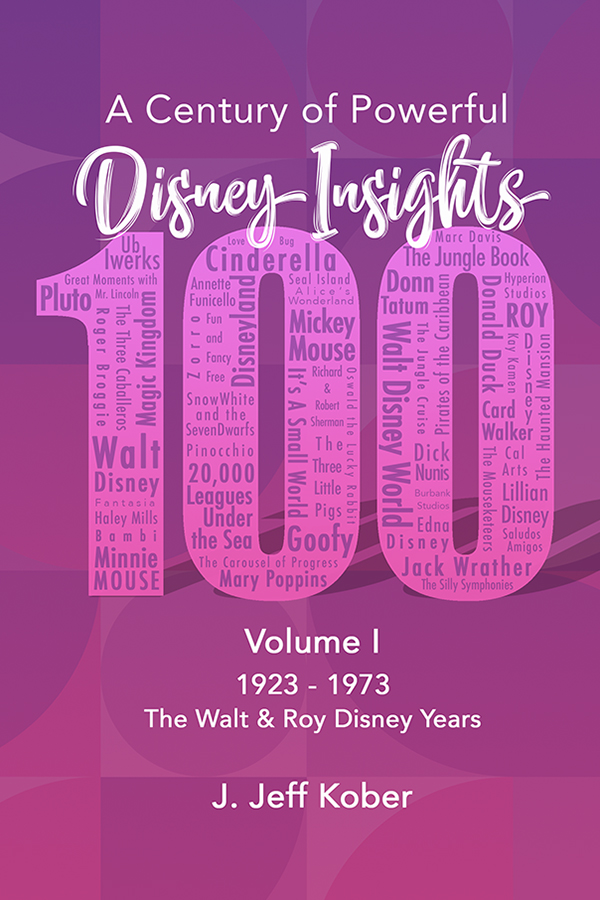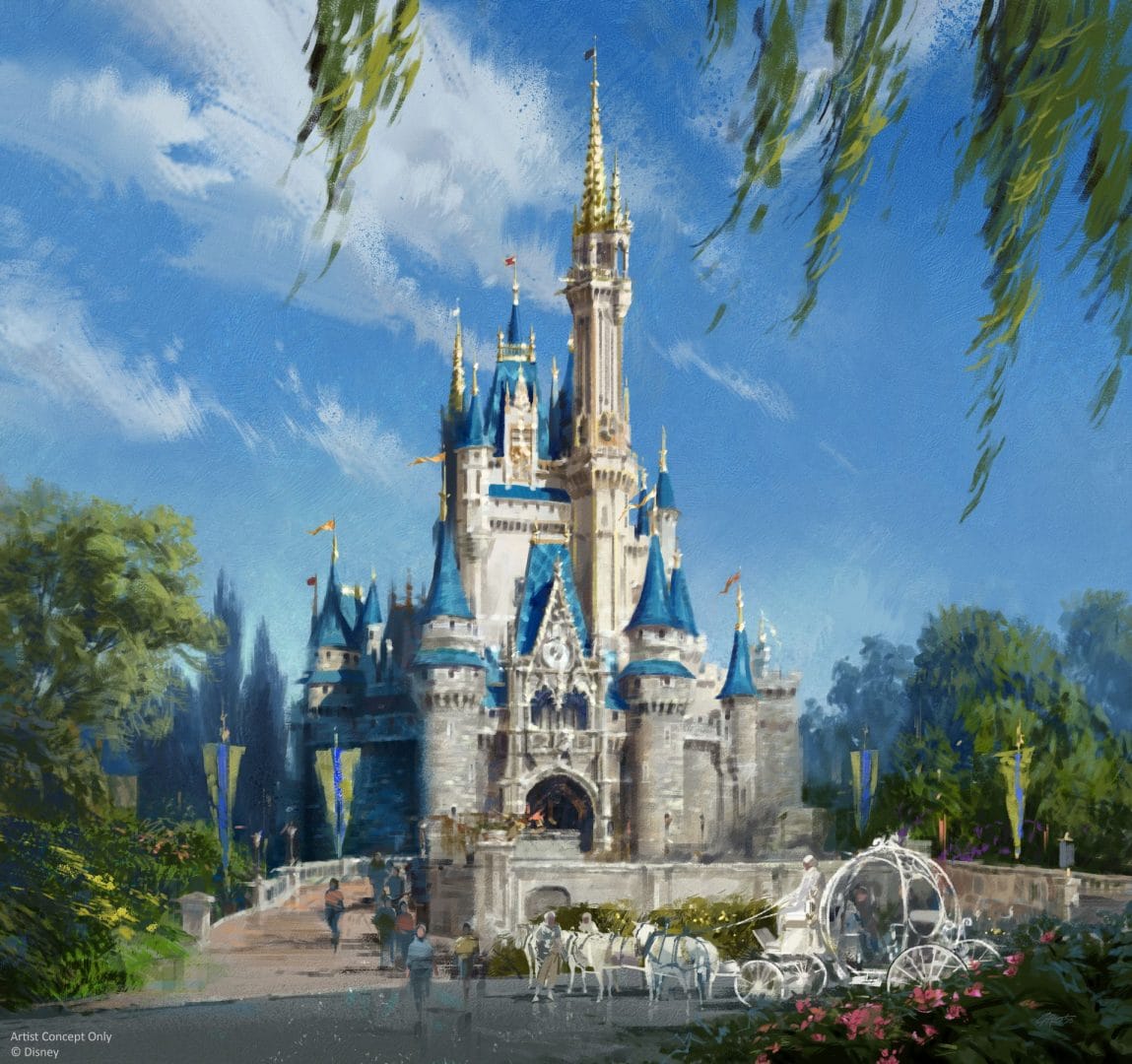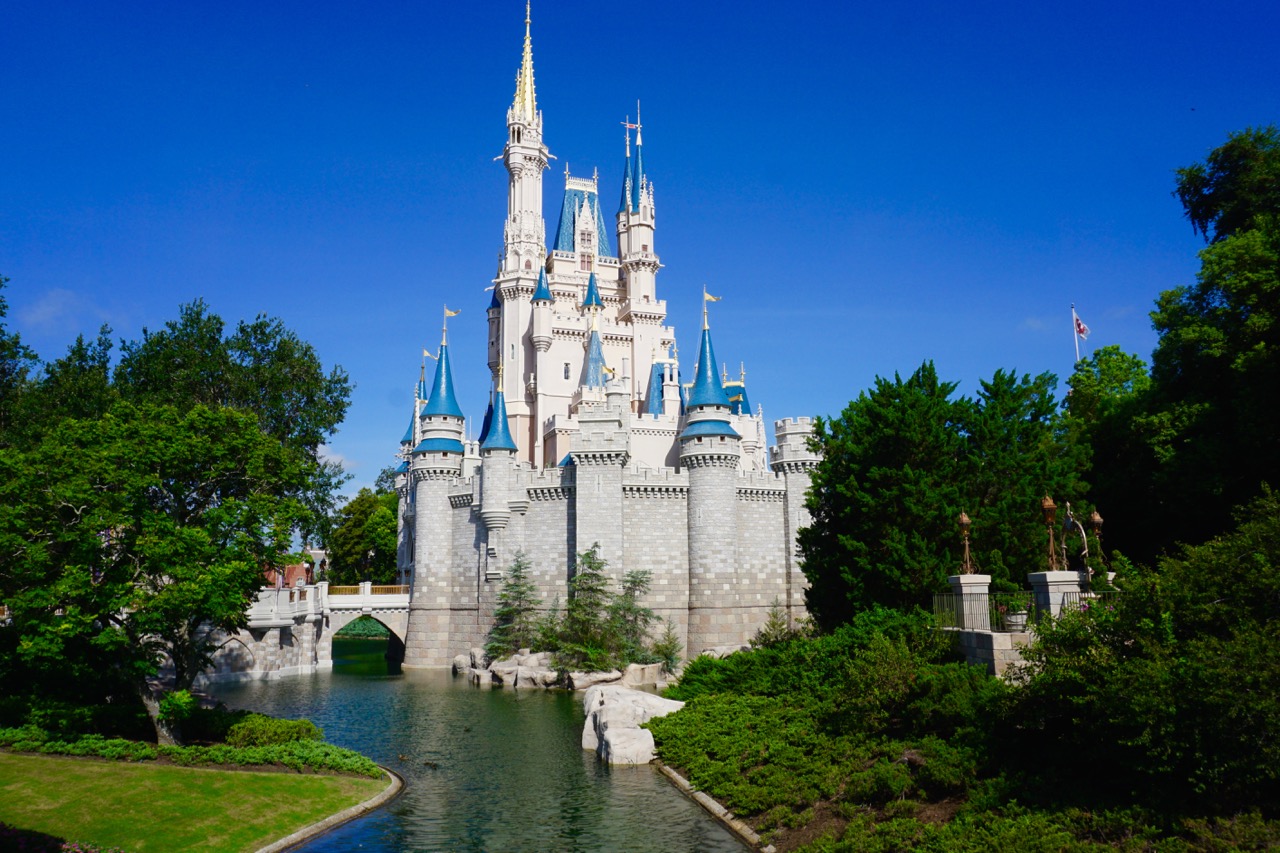Putting the Fun in Funmeister: Insights on Pleasure Island–35 Years Ago
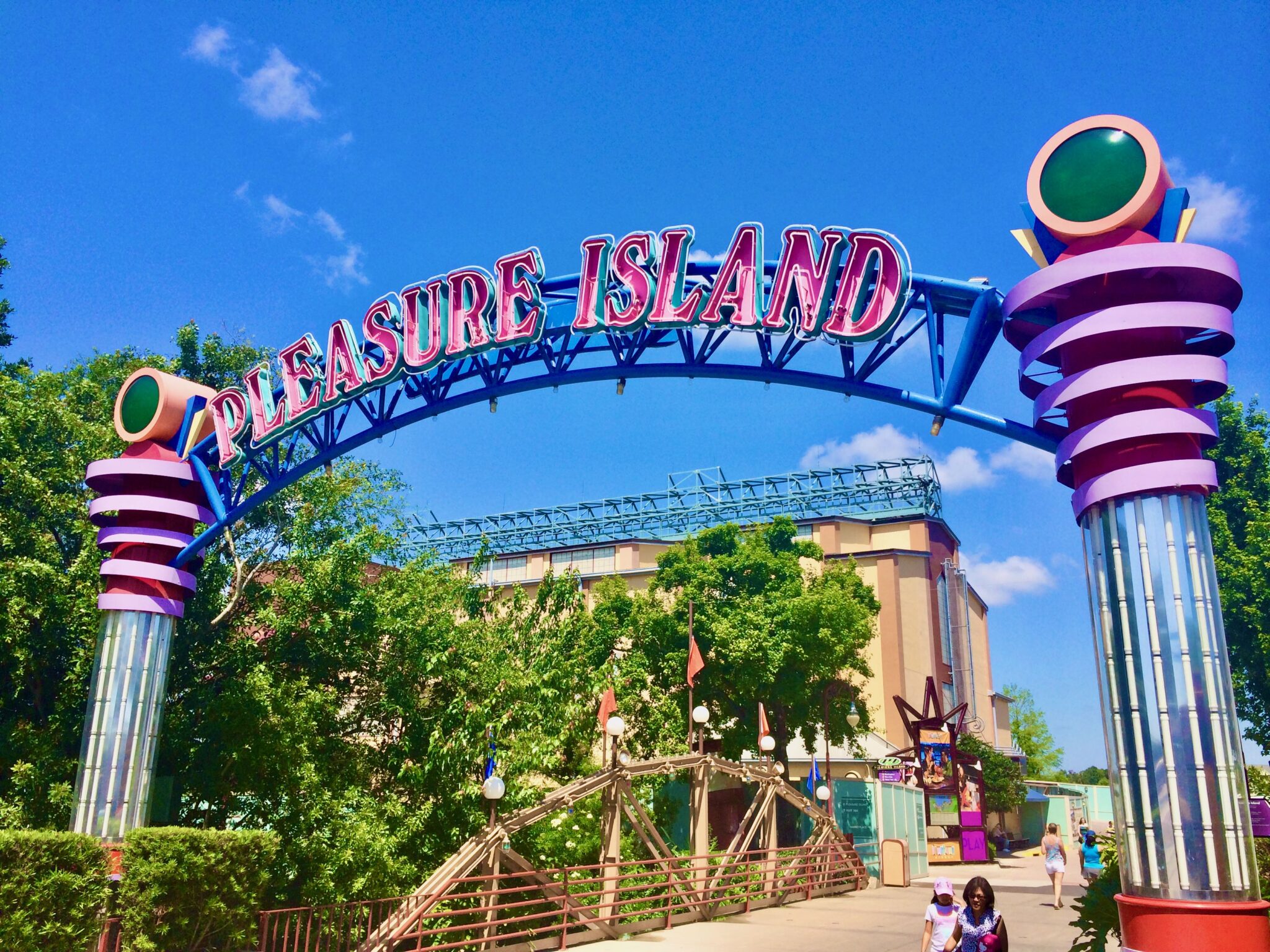
Like Disney-MGM Studios, Pleasure Island at Walt Disney World opened up 35 years ago. Also like Disney’s Hollywood Studios, it morphed over time. Unlike the studios however, it’s gone–with only a few remnants reminding us of that strangely unusual “outside the brand” creation. We consider each of the clubs, plus restaurants, stores and more. We look at how it got started, and how it met its demise. And I share my own personal stories of interacting with this unique entertainment offering and its incredibly talented Cast, all the while staying sober. Join us as we find insights from Walt Disney World’s Pleasure Island.
The substance of this topic can be found on our podcast. You can find this podcast on iTunes, Spotify, Podbean, and ListenNotes. Please subscribe to the podcast and to this website so you can be notified of upcoming posts and podcast.
Be sure to subscribe to this podcast and give us a rating, review, or referral to others. Also check out Disney Insights where we offer key points, photos, videos, links and more. While there, please subscribe to Disney Insights where you can be notified of upcoming podcasts. Also check out our Facebook page, Disney Insights and our YouTube page of the same name.
Beginnings
Pleasure Island was clearly a part of the Michael Eisner era, a time when Walt Disney World needed to become the biggest attraction in the world. Disney was in competition with places like Las Vegas, Branson, Missouri; an emerging cruise market and even resorts like Club Med, many of which were looking for more family audiences than adult audiences.
Locally as well, Walt Disney World needed to compete against every major attraction and venue in the greater Orlando area–especially Universal Studios. Their CityWalk was years from being created, but there was another club venue eyeing Disney’s attention. Church Street Station had been just that–a train station since 1889. But over time, an entrepreneur by the name of Bob Snow took over the complex and made it into an entertainment venue, similar to one he had done up in Pensacola. Opening in 1974, an amalgamation of clubs were combined under one price, and for the next couple of decades were very popular among the locals–especially those who wanted to get away from Disney, or didn’t want the hassle of driving all the way down into Disney.
Riding that line between adult clubs and family entertainment, Imagineers built out a club concept they thought would be a cool place to visit. They called it Pleasure Island, but someone at the top must have given a fit over its alliteration to the film Pinocchio (Eisner even refers to its origination as such) that they gave the most uninteresting and unrelated story about Merriweather Pleasure and how the island came to be. (Technically Pleasure Island isn’t even an island, as it was simply a ditch build around a parcel of land set aside that adjoined the lake). Actually, the entire look and feel of the island is largely based on the concept of Vancouver’s Granville Island, which took a warehouse district with restaurants, shops, clubs and theaters. And they probably took the word “island” from Granville Island for Pleasure Island.

Imagineers gave the design and concepts a ten year design lifecycle. That it lasted as long as it did is miraculous and also messy. It always struggled with being “on brand”. It was far more “grown up” than Walt Disney World operations had ever wanted a venue to be. But to keep families somewhat interested, they provided choices for teens wanting a place to hang out as well. The mantra was to get people to stay on property day or night–and this was a big answer to the stay at night problem.
Built in time to be part of the larger Disney-MGM Studio massive press event opening, work happened quickly to make this attraction open in time. In an act of resourcefulness, two closed railcars from the defunct Fort Wilderness railroad was moved from the campground, re-outfitted, painted and made into ticket booths entering the singular entrance (another would be formed near the West End Stage.
The place opened with six clubs all very unique. Let’s look at each and how they evolved.
Neon Armadillo
To understand competing against Church Street Station you have to understand that one of the biggest draws for the locals at that complex was the Cheyenne Saloon. It was a great place to club downtown with cowboy boots and it drew many acts that ultimately became successful like Alan Jackson and Garth Brooks. So it made sense to Disney to have a distinct club like Neon Armadillo. Eventually it would move to another larger location by taking over the Fireworks Factory. Here it would be named the Wildhorse Saloon with the BET Soundstage would take over the former Neon Armadillo. Towards the end the Wildhorse became a top 40’s dance club called Motion. And that was the end of the line dance for country music offerings at Walt Disney World.
Videopolis East, Cage & 8 Trap
Videopolis East was another offering that evolved. Of course Disney had to acknowledge that while Pleasure Island was not intended as a family place, there should be something for young adults or teenagers. The perfect answer for this was Videopolis East, a much smaller version of Videopolis that was created for Disneyland in California. Established in 1985, It was a hot spot for young people looking to go somewhere on weekends. Its roots began with Date Night at Disneyland at the Carnation Gardens and then evolved in the later 1960s to the Tomorrowland Terrace with its stage that moved the band from below up to the crowds on the dance floor. So Videopolis was welcomed as the next “big thing” to come in terms of a place for kids to rock out to at Disneyland

But that offering under the same name did not stick the landing in Pleasure Island. No one knew anything about what Videopolis was, and what it was at Pleasure Island was a fraction of the huge event stage extravaganza at Disneyland. Videopolis East was not only poorly received, but it was off-brand to what Pleasure Island was supposed to be.
Partly because of this mix of teenage and adult offerings, Pleasure Island was trying to ride the line of having something to offer to young adults. But all of that served to splinter the offering and lose any synergistic appeal. All of this was spoken of by Michael Eisner in his biography, Work in Progress.
From this a new adult venue took over Videopolis East and was called Cage. It was more a cacophony of steel. A much better concept came along in time called 8 Trax, which perfectly targeted guests who grew up listening to such. It became a better example of what who the brand was really trying to target.
Other changes came at this time. One of them being the FunMeister, who played an important role in marketing the concept of fun at Pleasure Island. It had a similar look to Mac Tonight, a fictional crescent moon character McDonalds used. FunMeister was part of the marketing to get people to turn out. It too had a 90’s look to it, full of teal, hot pink, golden yellow, and royal blue–much like the facility itself. When FunMeister went away, it was never really quite the same.

Part of what did work was an annual pass that could be had for about 3 visits, or about $37 dollars. This served especially to bring in the local audience, and that helped boost highly attendance in a major way, especially at Mannequins.
Mannequins Dance Palace

If anything brought in the local audience, it was Mannequins Dance Palace. But the local audience wasn’t Orlando residents per se, it was Disney Cast Members. This club resonated well with young Cast Members, especially college program Cast Members, and particularly the LGBTQIA or Gay community as it was largely referred to at the time, if referred to at all. If you weren’t aware, among Cast Members the word EPCOT stands for Every Paycheck Comes on Thursday. So Thursday nights and into the weekend were always strong at Pleasure Island, but especially Thursday. Many a Cast Member would wake up on Friday mornings realizing they didn’t have anything in spending money until the following Thursday pay day.
Mannequins was uniquely designed in terms of layout. You entered via an elevator. That elevator took you to the top 3rd floor, where you would then work your way back down to the bottom where a large revolving floor would rotate. This did a terrific job of dispersing the flow of guests throughout the building, and not just bunching everyone right at the entrance or exit. It was named Mannequins for the large number of such figures throughout the building, all wearing some strange costume or attire tied to dance itself in some way. You could find recreations from the “Shall We Dance” moment in The King and I to costumes from the musical Cats. But the real show was much more lively. The Pleasure Island Explosion Dancers put the nineties into the nineties. Their look and choreography speak to that decade better than any. And they were probably the most talented, hardest working dance ensemble on property, backed up by a state-of-the-art sound system and a lighting package behind its stage that was so intense that it was known as the “Toaster Oven”. It had its own programmed light shows each night.
The West End Stage & New Years Eve Every Night

Mannequins had no difficulty creating the most intense party experience, but the job was to get all of Pleasure Island moving to the beat. So when they weren’t dancing at Mannequins, The Pleasure Island Explosion Dancers could be found gyrating between band acts and the DJ on the West End Stage. But still this was not enough. Under new management’s direction, Pleasure Island started doing New Years Eve nightly with both the band and the dancers together creating one big moment on the West End Stage. Just add a dozen skylights, a bursts of fireworks and some confetti–actually dumpster loads of confetti, and you had people staying through the night, rather than checking out a club or two for an hour and going home. This was the equivalent of fireworks at the parks–it kept people spending and having a good time. It also became a signature piece that kept Pleasure Island feeling like it was the hottest club in town.
XZFR Rockin’ Rollerdrome & Rock ‘n’ Roll Beach Club

When it originally opened, It started as a place that combined roller skating and dancing to pop hits. Now add liquor. Oh, and did we mention minors? It was an attorney’s nightmare made in Xanadu. Partly because the “roller rink/disco emporium” concept or theme included the idea that Merriweather was excited about outer space and possible aliens. So he built experimental aircraft, and beamed out messages to intelligent life forms wherever they could be found. Now those same space craft inventions were vehicles for DJs to host a party.
This lasted no more than a year. Was shuttered in 1990 and became simply The Beach Club. But just like Mannequins, it was a popular and one of the biggest hangouts for those looking for a place to drink and dance.

The Comedy Warehouse

No neighborhood of clubs would be complete without a comedy club. A nightclub that featured an improv comedy troupe. This was born out of a comedy improv “movement” that was known in Orlando as the SAK theater. This group was so popular that Disney approached them to provide entertainment at Epcot in Italy, UK and around Future World. Craig McNair Wilson was the artistic director of this and according to an article by Wade Sampson (the beloved Jim Korkis), Wilson himself coined the term “Streetmosphere”. He was at the same time creating the Citizens of Hollywood that were so beloved at Disney-MGM Studios. It was he, Chris Charradine (architect) and Joe Rhode that built out the Meriweather Pleasure story that answered to why these warehouse buildings were there in the first place.
There were many concepts Wilson was involved in, but key to the improv group’s success was The Comedy Warehouse. The Comedy Warehouse originally featured a parody show called “Forbidden Disney”. This tied in with the Disney props–some bizarre–that could be found throughout the warehouse. After a few seasons it became more of a comedy improv format. Think of this as something akin to Whose Line Is It Anyway? That show included Wayne Brady who was part of the SAK theater group. The reason for an improv format was that the club played to a largely repeat audience, which became the same problem with the Adventurers Club. All this helped to keep the show fresh, and you were always waiting in line for the next show, if not the one after that.
The Water Maniacs
At the same time this was going on, I was director of operations at Water Mania. It was a small water park down 192, not much larger in size than Pleasure Island itself. Among my many duties (aquatics, rentals, F&B, retail, admission and others) was to be responsible for entertainment. The water park had a big DJ booth overlooking the big wave pool, and it had a DJ who had made a big name for himself in the community. So big that Disney gave him a big offer to work all of their DJ gigs–largely big ballroom events. I needed a new gig, and my inspiration came from Pleasure Island. I thought we could combine improv with the beach club theme to create the Water Maniacs, a DJ group composed of SAK comedy theater recruits who were taught how to be DJs. My thinking was that you could train comedy improv folks to become a DJ, but you couldn’t get a DJ to master comedy improv.
I reached out to SAK and they sent over a group of possible hires that I auditioned. I ended up selecting 7 or 8, as I needed to not only staff the DJ booth at the Wave Pool 7 days a week, but run a secondary and temporary DJ booth at the Wipe Out–Orlando’s first and exclusive automatic surfing machine based on FlowRider technology. I then went and sought out DJs at The Beach Club. I told them my vision to have them create the right play list for the park, the right equipment to play it on, and the training to teach the Maniacs how to be DJs. In addition to pay, they each got free Water Mania passes for them and their girlfriends. We ran the concept all through the summer with the Maniacs not only playing the best hits, but running around the park doing contests and games and of course, working the crowd with their comedy improv. What the Maniacs loved about the gig was they could work daytime shifts, and then do their nighttime shows. What they hated was hauling equipment to and from and having to work in intense heat.
Comedy improv found another home at Pleasure Island: The Adventurers Club.
The Adventurers Club
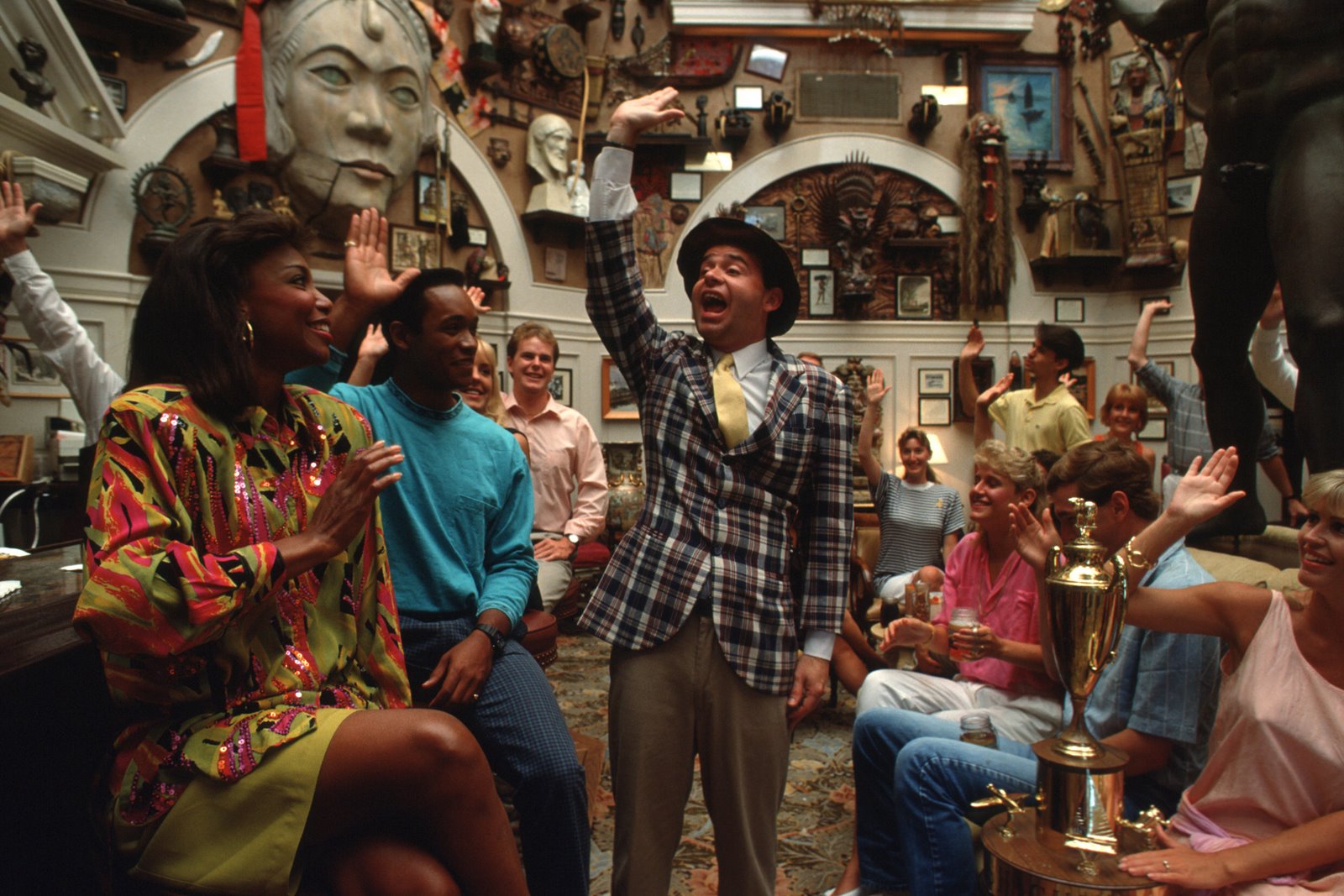
The Adventurers Club was a happy accident of an idea that was born of separate concepts to include the romance of Rick’s Cafe in Casablanca, Tamara, a live theatrical multi room play in Los Angeles, as well as a backyard event Joe Rhode would hold known as “The Last Days of the Raj.” This concept evolved a little at first. Birnbaum in his 1988 summary spoke of this club being a “place of gypsies and ghosts where a certain Miss Zenobia tells tales and fortunes to those at the Illusions Bar. Masks and shrunken heads festoon the walls; an organ plays by itself in the library/saloon.” In truth, much of this exists, but there more merry & mirth than foreboding.
Joe Rhode brought in the eclectic look and feel of the club. Roger Cox was the director and writer for Adventurers Club, and Wilson along with others were brought in add night to figure out how the cast/audience interaction that guests have loved for 35 years. This was the thing that made the Adventurers Club succeed so well, was its cast of characters. Names and characters like Hathaway Browne, Fletcher Hodges, Otis T. Wren, Madame Zarkov, Pamelia Perkins and Samantha Sterling were loved and embraced by visitors as if they were their own strange family members. The improv that occurred was the best of the best, and guests returned again and again as if it were a family reunion nightly.
But its popularity was also part of its problem. Like the comedy warehouse, regulars or annual pass holders would keep coming night after night. They tended to buy less booze, and inevitably the real revenue of the place dried up, figuratively and literally. I was with The Disney Institute and in the late nineties tried to figure out how to utilize this space for groups during the day before it was put into show mode at night. I moved back and forth between the onstage spaces and the tight backstage quarters. The reason the whole area, known as Hill Street, slopes upwards toward this end of the island is that there were dressing rooms that ran under the street between Adventurers Club and Comedy Warehouse. It did much to creating a collegial group among the cast and in its own right was an intriguing world in and of itself. But the place reeked of spilled booze, and without the players and the show going on, it was not conducive to bringing people in, much less business executives wanting to know the business behind the magic.
Still, this is the most remembered attraction above and beyond everything at Pleasure Island. It was even the one part of the Merriweather Pleasure story that worked in that he established The Adventurer’s Club, which ultimately led him to have a chapter group that was part of the Society of Explorers and Adventurers. Curiously, this theme has gone on longer than the entire Pleasure Island concept itself, with references played out nearby at the Magic Kingdom (Skipper’s Canteen) and in far away places like Tokyo DisneySea (Tower of Terror & Fortress Explorations) as well as Hong Kong Disneyland (Mystic Manor).

Restaurants, Shops & More
By the way, ideas of doing a restaurant as part of The Adventurers Club was batted around forever. Its previous location is now The Edison. But other restaurant concepts were a part of this place called Pleasure Island.
Fireworks Factory
The first of these restaurant concepts is the Fireworks Factory. This Levy Restaurant was built on the idea of a factory whose operation was just that–fireworks. Even props in the restaurant were on loan from the Gucci’s, a famous fireworks family in New York. That theming was tied into Typhoon Lagoon where a firework explosion scattered dynamite throughout the community. Look for this when you are in the queue of the original family water slides. Undetonated explosives can be seen as far away as here in Mount Tilly. In the end this restaurant was replaced by the Wildhorse Saloon, which would at the very end be replaced by another club called Motion.
Speaking of Typhoon Lagoon, did you ever consider the contrast of this locale based on a typhoon to that of Pleasure Island where the man in charge is named Merriweather (Merry Weather)? His demise was actually due to Hurricane Charlotte–which no one knew. But no one really knew the origins of Pleasure Island anyway.
Portobello Yacht Club
Portobello Yacht Club was originally intended to be a T.G.I. Fridays. Instead it has taken a decades old Mediterranean style look and taste. It is now known simply as Portobellos and is operated by Levy Restaurants as well. It had a problem in that it was not part of the gated island community of Pleasure Island, but it was part of its offering. That may have been a blessing to Portobello and perhaps a reason why it exists still today. You don’t need a ticket to get into it. It probably also maybe explains the demise of the Fireworks Factory.

Empress Lilly to Fulton’s Crab House to Paddlefish
The Empress Lilly was still in her original glory when Pleasure Island opened, and served as a listed formal dining experience of Pleasure Island, even though technically this ship (which is a building sitting on water) was not even inside the “island” per se. Over time it has gone through changes since 1996 of becoming Fulton’s Crab House and then Paddlefish. It is now operated by the Levy Restaurant family as well. But in its earliest day, it was the place to find jazz. So as that restaurant experience evolved, jazz found a home by taking over the former Merriweather’s Market.

Merriweather’s Market & Pleasure Island Jazz Company
Merriweather’s Market was the counter service answer to Pleasure Island, because anything with the Disney name behind it has to include a counter service. It was poorly received and was replaced by the Pleasure Island Jazz Company, which put a jazz club within the confines of the island itself. Still, it would be replaced by the Raglan Road Irish Pub, which stands in that same place today.
AMC Pleasure Island
Not long after Pleasure Island opened, AMC moved in next door further in 1990 pushing the entire property further west. It opened with 10 theaters but by the time Disney’s West Side opened, it expanded to 24 theaters. It has the distinction of hosting one of the premieres for Dick Tracy. For many, this was the nicest theater in this part of Orlando.

Planet Hollywood
Early on before Pleasure Island came to be, the Hard Rock approached Disney about putting in Hard Rock Restaurant. Disney thought it could do it alone, and turned them down. They went to Universal Orlando and ultimately created a guitar shaped restaurant, that would be replaced by another in City Walk, and a hotel where the original restaurant stood. Today, Hard Rock more than 250 + Cafe, Hotel, Casino, Live and Rock Shop venues in over 70 countries.

Realizing their mistake they went to a comparable, popular venue of that same era known as Planet Hollywood. It was a hot property back then, made famous by its co-owner, Arnold Schwarzenegger, Sylvester Stallone, Bruce Willis and Demi Moore. The weekend the three tiered globe was dedicated was a big ticket to get into and for years it was one of the most difficult restaurants to get into despite its burgeoning three floors of movie related props and dining experiences. A gator stood on top of a nearby kiosk making the popular t-shirts and other retail easy to by.
There are only four restaurants today, plus a comparable number of resorts. Yet the signature restaurant still stands in Disney Springs, having been remodeled in 2017. It’s global shape is still provocative, even if the gator isn’t around any longer.
Shops
Pleasure Island also had some one off shops that were pretty interesting. The one place honoring Who Framed Roger Rabbit’s famed femme fatal was Jessica’s, which included a huge two-sided, thirty-foot neon sign complete with swinging leg. It would be moved to the West End Stage after the shop closed.
Avigator’s Supply sold Adventurers Club and Indiana Jones style merchandise. This would be replaced by Paradiso 37 in time.
And for those looking for unique real movie finds checked out Reel Finds for increasingly popular Hollywood style memorabilia.
The problem with all of these elements like Planet Hollywood and AMC Pleasure Island is that you had to walk through a “dead” Pleasure Island to get to them during the day. The place stunk, was nothing more than hot colored concrete in the sun, and was on an incline, making it difficult for many to even walk up and down.
Death & Evolution to Disney Springs

In the end, four things primarily killed off Pleasure Island:
First, an evolution of a generation of people who grew up and out of the Pleasure Island. The next generation didn’t see Pleasure Island as being the place to be seen and heard.
Second, added to this was the evolution of this entire Disney property. In the mid 90s, the Universal Hollywood park opened an adjacent place known as City Walk. It was hugely popular, and Disney wanted to replicate that in some form. That form was largely known as Downtown Disney West Side, which included several restaurants like Gloria Estefan’s Bongos and Wolfgang Pucks, plus an expanded AMC movie theater complex, a Virgin Record Store, a Disney Quest arcade experience, and a Cirque du Soleil theater. People loved this new area, and the whole of it would be retitled as Downtown Disney.

Third, The complication came from people who wanted to get from Downtown Disney Village Marketplace over to Downtown Disney Westside. Because you had to have a ticket to walk through Pleasure Island, the only way to get over was waiting for a boat or going out into the parking lot and taking a sidewalk to get from one side to another. This really made the entire experience arduous. They sought to correct that by opening up the space at night and making the clubs require the admission, but that took the party out of Pleasure Island. It just wasn’t New Year’s Eve every night any more.
Fourth, not only did Disney want to replicate the Universal Hollywood City Walk, but so did Universal Orlando. And the advent of that big complex not only made for huge competition, but also made it easier for residents in Orlando to get in and out of. It would not only impact Disney’s own attendance, it would also add to the ultimate demise of Church Street Station.

All of It came to an end by 2008. The dead end of the property was torn down with intent that it would become Hyperion Wharf. But management changed and a new vision was placed on the table that would allow the entire retail operation to be reconfigured under the title of Disney Springs. It is now largely the area known as The Landing at Disney Springs. It is a more fluid pedestrian space, and blends in with the entire retail, dining, entertainment location.
A Century of Powerful Disney Insights Book
You can order my newest book, “A Century of Powerful Disney Insights” on Amazon. It’s a great way to celebrate the 100th anniversary of The Walt Disney Company. In over 100 years, The Walt Disney Company has emerged as one of the most successful entertainment entities across the globe. In this, the first of two volumes, we study the first 50 years of Disney, beginning with Walt and Roy. We look at major milestones and not only see the evolution of an organization begun in a garage, but how it truly became so beloved to millions around the world. From Oswald the Lucky Rabbit and Mickey Mouse through Snow White and Cinderella, from the Mouseketeers to Mary Poppins, and from Disneyland to Walt Disney World, we share stories and insights from 1923 to 1973. We hope you’ll be inspired with ideas and how you can apply these stories to your own life and work.
Join the Wayfinder Group
The Wayfinder Society is our Patreon group. Here we bring the best details of Disney both in terms of the magic of the parks as well as the business behind the magic. It’s part of what you get when you help support the Wayfinder Society. For as little as a dollar a month, this Patreon group not only helps to support this podcast and attending websites, but also gives you access to one of our Disney at Play Interactive Guides.
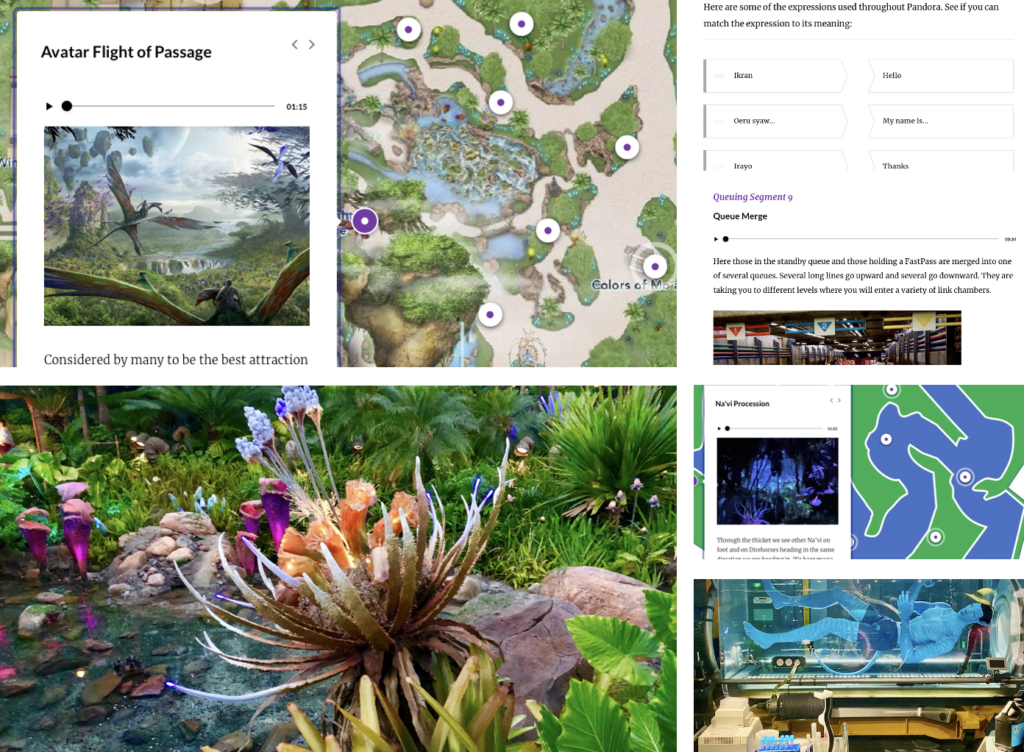
Check out the Wayfinder’s Society to see these Sneak Peeks!
NOTE! with any Wayfinder membership, you will also get exclusive podcasts looking that checks out other Disney podcasts, social media finds, shows, books and more.
Want to Create Excellence in Your Organization?
This podcast and post is provided by J. Jeff Kober and Performance Journeys, which celebrates more than 20 years as a training and development group bringing best in business ideas through books, keynotes, workshops, seminars and online tools to help you take your organization to the next level.
Want a Keynote Speaker? More than just nice stories, I offer proven insight and solutions having worked in the trench.
Need Consulting? I’ve worked for decades across the public, private and non-profit arena.
Need Support? We offer so many classroom, online, and other resources to help you improve your customer service delivery, leadership development and employee engagement.
Contact us today, and let us help you on your Performance Journey!
